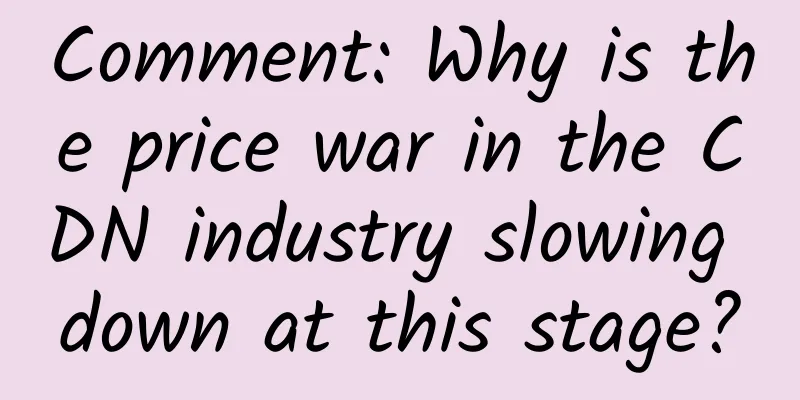Comment: Why is the price war in the CDN industry slowing down at this stage?

|
In the past two years, cloud computing companies have rushed into the CDN industry. The stable competition pattern in the industry has been broken, which is directly reflected in the price. The price decline rate in normal years is about -6%, and in 2016 and 2017, the price decline rate was about -20% for two consecutive years. Since July 2017, there has been no substantial drop in the price of the CDN industry. The price reduction has changed from being measured in yuan to being measured in cents. As of now, the industry's prices have tended to be stable.
Why is the price war slowing down at this stage? 1. The marginal effect of price wars is weakening Price is a stepping stone, which is usually effective in the early stage of entering a market, when the market share is from 0% to 10%. Now the market share of the two cloud companies has obviously exceeded this number. One type of price-sensitive users have migrated over the past two years, and the potential market is shrinking. Another type of Internet companies that will not go to the cloud avoid exposing their core operating data from a competitive perspective. 2. Rigid marginal cost of operation All variable costs will be bandwidth costs. In the early stages of CDN operation, when the scale is relatively small, cloud companies can take advantage of the overall large-scale advantages of cloud computing and have the advantage of reducing marginal costs. However, as the proportion of CDN business in cloud computing increases, the rigid costs of CDN are all bandwidth costs, which cannot be further compressed. The cost of traffic will increase linearly with the expansion of CDN scale, and the price war will directly lead to increased losses. At the same time, recent industry media reports have said that the Ministry of Industry and Information Technology will subsequently regulate companies that privately build transmission networks, which may lead to further increases in traffic costs. 3. Price + Service is the Ultimate Model From price competition to quality competition, service is an inevitable process. Market share is not determined by a single price factor, but is also affected by multiple factors such as product technology and service capabilities. As a B2B business, customers will not only choose the service with the lowest price; if you only adopt a low-price strategy without optimizing and improving products and services, then when the subsidy ends, customers will also be lost; In summary, in 2018, the CDN market competition stage will shift from price competition to service quality competition, and the price reduction will return to a reasonable range in the market. |
>>: What IoT strategies do global operators have?
Recommend
6G is coming? Is it too early to start 6G research now?
With the implementation of 5G, the direction of m...
Five ways to ensure your applications are cyber resilient
The massive shift to remote work caused by the CO...
31 giants including Microsoft and Google form an alliance to prevent any company from dominating the 5G market
[[325080]] May 7 report: Foreign media said that ...
10gbiz: Hong Kong/Los Angeles VPS 40% off in August, starting at $2.36 per month, 258IP cluster server half price for the first month
10gbiz is a hosting company founded in 2020, prov...
CrownCloud: $5/month-4 cores/2GB/30GB/2TB@1Gbps/Los Angeles & Miami & Atlanta & Netherlands data centers
CrownCloud is a foreign hosting company founded i...
Fast, intelligent, and secure cloud application delivery is the new trend in 2017! F5 invites you to start a more free cross-cloud journey
[51CTO.com original article] Cloud computing has ...
Rooted in China for 20 years, F5 "Code to User" Online Summit kicked off grandly
[51CTO.com original article] On May 20, 2020, F5,...
Why has 5G, which has been hyped for so long, suddenly stopped working? How far are we from the 5G era?
Every time 5G is mentioned, we feel like we are t...
SD-WAN Today and Tomorrow
[[429002]] Traditional network technology faces e...
Building "China's Most Secure Cloud"! Huawei Cloud Passes the Most Stringent PCI-DSS Security Certification in History
[51CTO.com original article] On March 22, Huawei ...
GSA report: 63 operators around the world have launched commercial 5G services
The latest global 5G network development report f...
How 5G will revolutionize healthcare
Today, the development of 5G technology (fifth-ge...
Exploration and practice of full-link grayscale solution based on Istio
background Under the microservice software archit...
How to switch IT service providers with minimal business disruption
At the beginning of 2020, many organizations list...
Signaling analysis: Why did KDDI's major outage last for 60 hours?
The KDDI network failure that occurred a few day...









